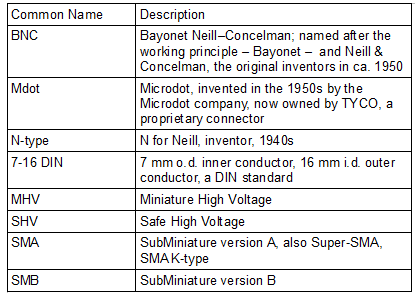Understanding coaxial feedthroughs for coupling sensitive and high frequency signals into and out of UHV/High Vacuum.
There are many different ways to transmit sensitive signals into UHV or High Vacuum, but the most common approach is to use coaxial (coax) feedthroughs.
Coaxial means simply that two conductors share a common axis. In a coax feedthrough the inner conductor is for a (typically small) signal and the outer conductor is connected to ground and works as a shield of that signal against electro-static interference.
However coaxial feedthroughs and connectors are used for a vast array of signals, and often the outer conductor will not be connected to ground or it will be connected to what is called a virtual ground. For these applications it is important that the feedthrough type is Floating (F). This means simply that the outer conductor can be connected to ground, but it can also be connected to a different voltage, as it is insulated from the flange itself (which for user safety is almost always at true ground).
Coax feedthroughs can be used for shielding sensitive direct current signals, but they are also often used for signals transmitted with a certain frequency (modulated, RF etc.). For high-frequency the impedance between the outer conductor and the inner conductor is important. 50 Ohm is the standard impedance matching (50) used in vacuum feedthroughs.
For in-vacuum connectivity double-sided (D) feedthroughs can be convenient, offering a familiar connector both on the air and the vacuum side. Though their respective cost is higher than single-sided, they greatly simplify in-vacuum connections – particularly useful for cables that need to be removed regularly, or for high frequency signals sensitive to the smallest mismatch.
Allectra offers amongst others BNC (also Mdot, N-type), MHV, SHV, 7/16, SMB, and SMA also 18G, 27G, 40G and 65G feedthroughs and connectors. Furthermore multi-pin floating coax pins in a sub-D feedthrough (up to 5 in a D25 footprint) are also available.
All Allectra feedthroughs are manufactured using welding and brazing techniques and do not use O-ring seals (with two exceptions – see below). If welded into CF style copper gasket flanges, they are fully UHV compatible and can be baked for system outgassing if required. (The maximum temperature depends on the feedthrough type, please refer to the Allectra Web Shop for details).
For High Vacuum applications, Allectra coaxial feedthroughs may be welded into KF style flanges for clean, quickly demountable connections.

High Frequency
While 50 Ohm BNC, SHV, and MHV can transmit modulating signals, for frequencies in the GHz range the vacuum industry standard is the SubMiniature (SMA/SMB) feedthrough. With increased maximum frequency the performance demands on the feedthrough, connectors, and cables also increases significantly.
Standard 50 Ohm SMA feedthroughs are rated to 6.5GHz, while the SMAD18 extends this range to 18GHz. The new double-sided SMAD27G uses the Super-SMA design to extend the maximum frequency to up to 27GHz, exclusively offering HV/UHV compatible plug&play high-frequency connectivity. The Viton™ O-ring sealed SMAD40G, using K-type SMA technology (2.92 mm), supports frequencies up to 40GHz. The Viton™ O-ring sealed SMAD65G, using K-type SMA technology (2.92 mm), supports frequencies up to 65GHz. Every SMAD40G feedthrough and SMAD65G feedthrough is delivered with a test certificate and demonstrates well-defined VSWR and insertion loss characteristics.
HV/UHV connectors and cables
Beyond the feedthrough Allectra is a world-leading supplier of UHV/High Vacuum cables, and can offer Kapton-insulated coax cables such as 311-KAP50, pre-confectioned and made-to-measure cables such as the 380-SMA-MM-1000, and even UHV compatible semi-rigid cables for high-frequencies (max. 40GHz) like the 380-SMAK-MM-500.
For details and specification of Allectra coaxial feedthroughs, please refer to the Allectra Web Shop.
